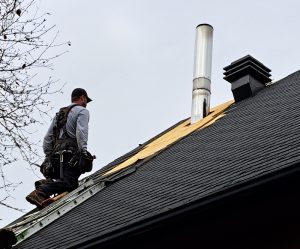You’re faced with a roof problem? Then you have to decide whether to repair or replace it. Understanding the options and factors to consider can help you make a better decision. We provide factual and straightforward information to guide you in assessing the level of roof repair needed.
The advises below are part of the Roof Repair Guide: Homeowners Resources.
Table of Content
Roof Repair Options
When dealing with a leaky roof, there are several repair options available to you. These options include patching, resealing, or replacing damaged shingles.
Let’s explore each of these techniques:
Patching: Patching is suitable for minor roof leaks caused by small punctures or localized damage. It involves sealing the affected area with roofing cement, sealant or patching materials specifically designed for roofs. Patching is a cost-effective solution for isolated issues.
Resealing: Resealing involves applying a fresh layer of sealant to restore the waterproofing properties of the roof. It is often used for roofs with minor cracks, gaps, or worn-out sealant. Resealing can be an effective solution when the roof’s overall condition is still sound.
Replacing Damaged Shingles: If the leak is caused by damaged or missing shingles, replacing them can resolve the issue. This method is suitable when the damage is limited to a specific area and the rest of the roof is in good condition.
Factors to Decide Between Repair and Replacement
Several factors should influence your decision between repairing or replacing your roof. These factors include:
Overall Condition and Age: Assess the overall condition and age of your roof. If the roof is nearing the end of its expected lifespan or shows significant signs of deterioration, replacement might be the more practical long-term solution.
Many things will affect your roof lifespan: the roofing materials used, it’s slope, and the elements (sun, wind, rain, snow/ice). But in general you can consider the average following lifespan for different roof materials:
– Metal roof: 50+ years
– Rubber membrane roof: 30+ years
– Asphalt shingles: 15-20 years
– Tiles or slate roof: 15-25 years
– Composite shingles: 12-15 years
Extent of Damage: Evaluate the extent of damage to your roof. If the damage is extensive, recurring, or affects a large portion of the roof, a replacement may be necessary to ensure long-term stability and prevent further issues.
Cost-effectiveness of Repairs: Consider the cost-effectiveness of repairs versus replacement. While repairs may be cheaper upfront, multiple repairs over time can accumulate costs. If the repair costs approach or exceed the cost of a new roof, replacement might be a more sensible investment.
Benefits of a New Roof:
Understanding the benefits of a new roof can help you make an informed decision. Some advantages include:
Energy Efficiency: Newer roofing materials and technologies offer improved energy efficiency, leading to potential energy savings in the long run. A new roof with proper insulation can help regulate indoor temperatures, reducing reliance on heating or cooling systems.
Increased Property Value: A new roof enhances the overall aesthetics and curb appeal of your home. It can also increase the market value of your property, making it an attractive feature for potential buyers if you decide to sell in the future.
Guidance on Opting for Repairs or Replacement:
Making the right choice between repairs and replacement depends on individual circumstances. Here are some guidelines to help you decide.
Opt for Repairs If:
– The damage is localized and limited to a small area.
– The overall condition of the roof is good, and it is still within its expected lifespan.
– The cost of repairs is significantly lower than the cost of replacement.
Opt for Replacement If:
– The roof is significantly aged or nearing the end of its lifespan.
– The damage is extensive, recurring, or affecting a large portion of the roof.
– The cost of repairs approaches or exceeds the cost of a new roof.
– You desire the long-term benefits of a new roof, such as improved energy efficiency and increased property value.
Do you need a permit to repair a roof?
It first depends on your city, town or county bylaw. In general, if the repair is small, you can do it yourself or have it done by a handyman, you won’t need a permit. In most cases a complete roof change needs be done by a professional company with the required permits and licenses.
As a rule of thumb you’ll need a permit for all repair or changes when more than 200 square feet or 1/10 of the total surfaces. Always see with your city or town to be sure.
You should always call and verify with your town administration to see if you require a permit or not.
When repairs are no longer sufficient or cost-effective, investing in a new roof becomes a wise choice for the long-term protection and value of your home.

